MARIANI’S
Virtual
Gourmet
April 14,
2019
NEWSLETTER
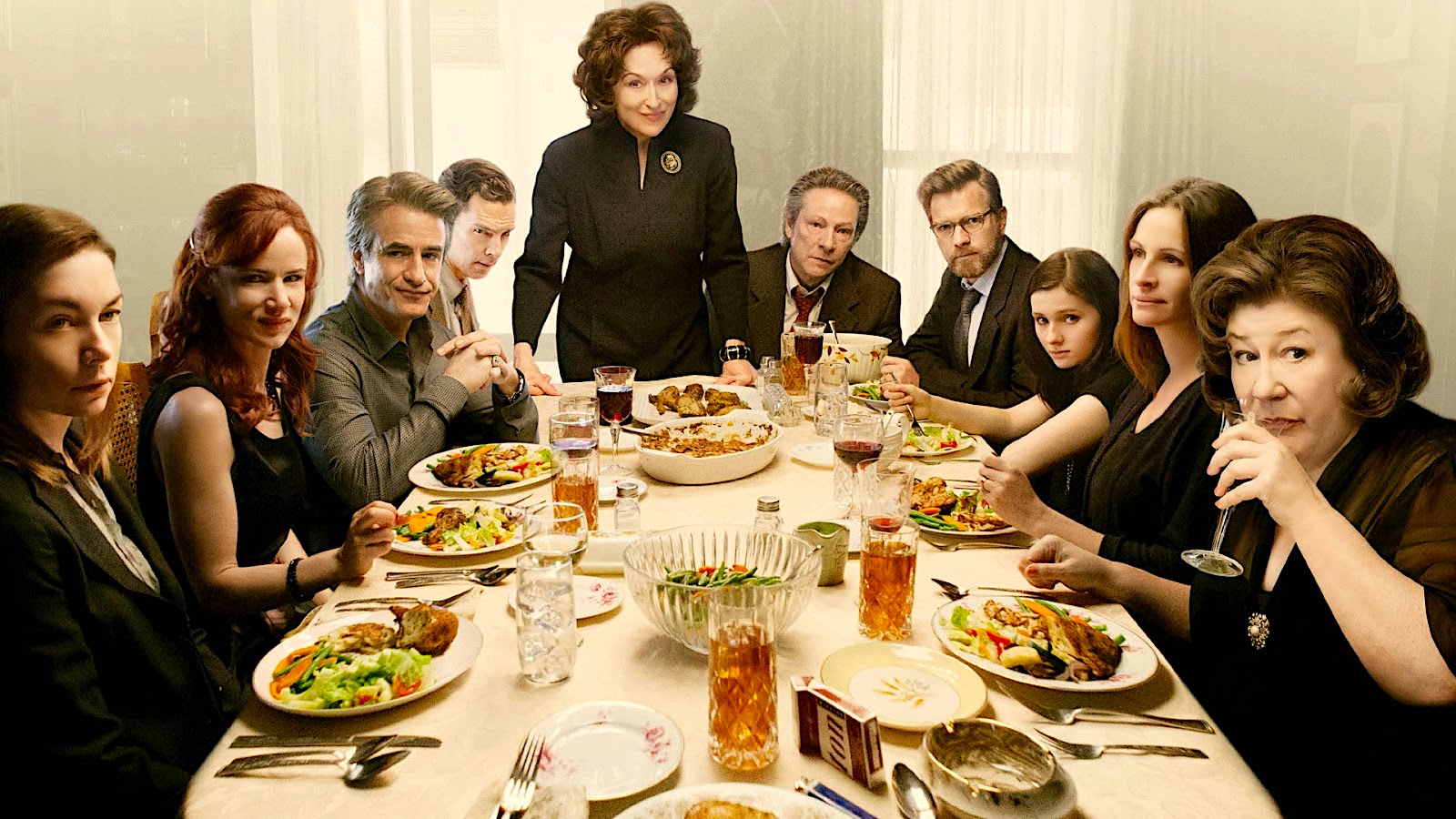
Abigail Breslin, Julia Roberts, and Margo Martindale in "August: Osage County" (2013)
❖❖❖
IN THIS ISSUE
Puerto Rico
By Geoff Kalish
NEW YORK CORNER
NAI TAPAS
By John Mariani
NOTES FROM THE WINE CELLAR
LARKMEAD WINERY
By John Mariani
❖❖❖
Eating Around Puerto Rico,
By Geoff Kalish
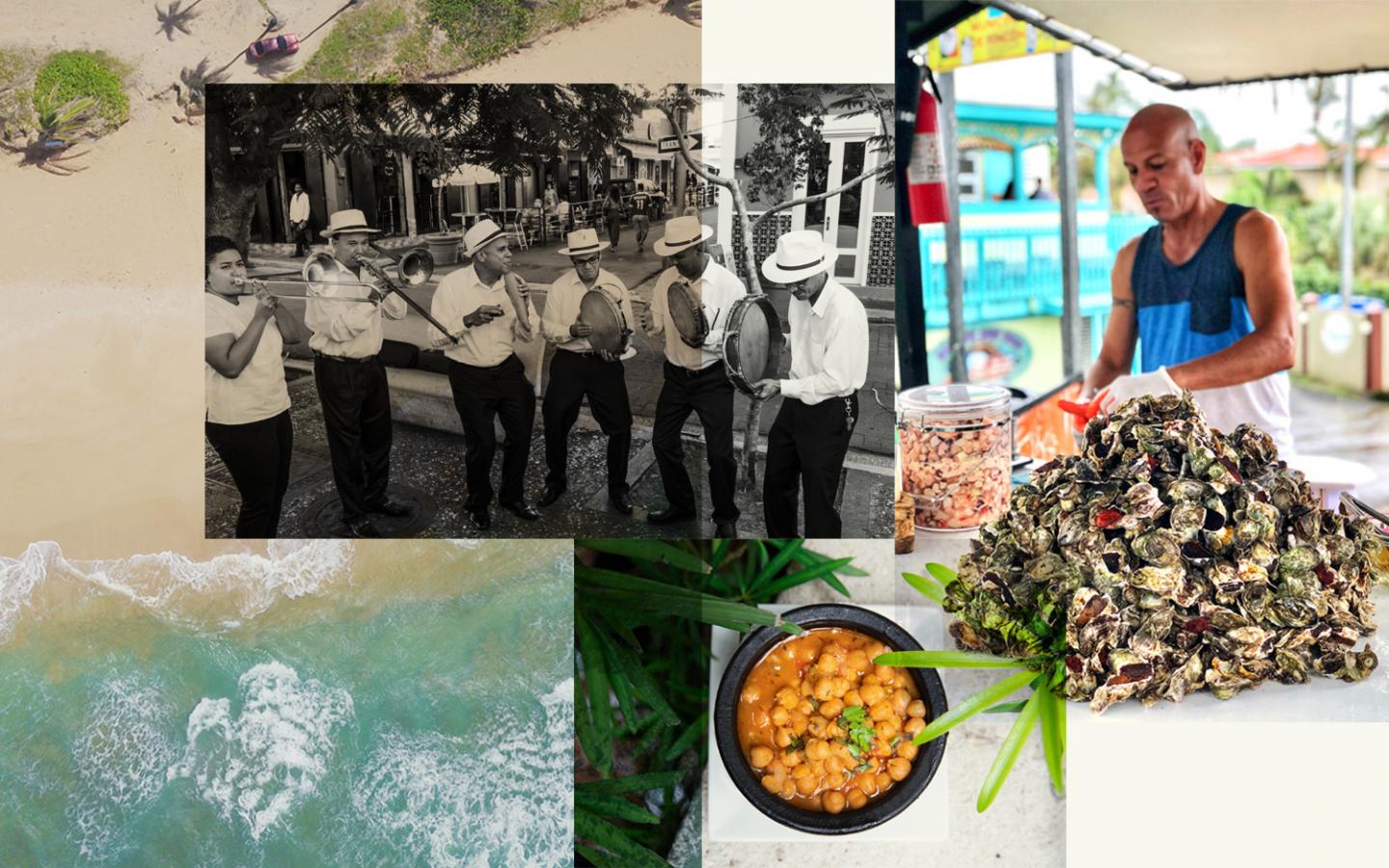
Hearing stories of “doom and gloom” about Puerto Rico in the aftermath of Hurricane Maria, I wondered before going if the crime rate was up, the service down, the drinking water potable, the beaches clean, the golf courses in good condition and whether all the good chefs were still on the island. To my delight, during a recent week-long stay, what I found was a relaxing experience with great weather, no crime, fine water, scenic beaches, great golf, flavorful fare and generally accommodating service (albeit not without some minor glitches).
The
Wyndham Grand Rio Mar
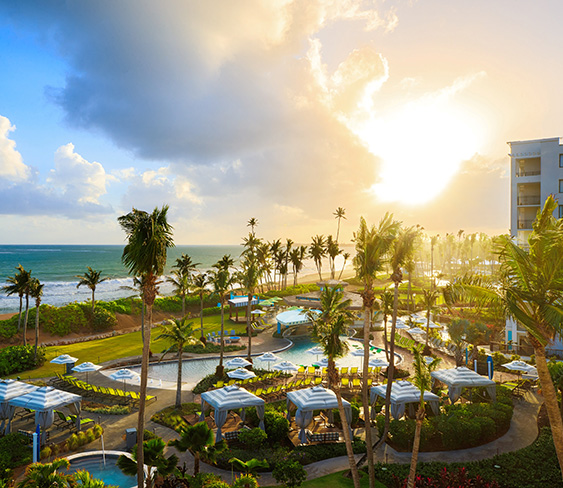
As they say in real estate, it’s “location, location, location!” And the reasonably priced, 400-room Wyndham Grand Rio Mar (about a 40-minute car ride east from the San Juan Airport) is set on prime real estate. It overlooks the El Yunke rain forest on one side and a number of pools, scenic beaches and turquoise ocean on the other. In addition to a spa, tennis courts, two well-maintained golf courses and a small casino, it features a number of dining options, like La Marbella for breakfast, and the four notable dinner spots (open nightly) discussed below.
Iguanas
 Situated a short
shuttle ride from the main door, above the
recently built golf shop, this large,
casual eatery offers salads and a range of
appetizers like sweet plantains stuffed with
tasty beef and zesty garlic shrimp doused
with lemon and rum. Also, there are a dozen main
courses available, particularly a moist, meaty
Caribbean lobster, served with either a spicy
Creole or tangy garlic sauce, and, of course, a
variety of flan creations for dessert.
Situated a short
shuttle ride from the main door, above the
recently built golf shop, this large,
casual eatery offers salads and a range of
appetizers like sweet plantains stuffed with
tasty beef and zesty garlic shrimp doused
with lemon and rum. Also, there are a dozen main
courses available, particularly a moist, meaty
Caribbean lobster, served with either a spicy
Creole or tangy garlic sauce, and, of course, a
variety of flan creations for dessert.
Of note,
the wine list (shared by two of the other
restaurants) features a number of top-producer
bottles from California. And, while pricing is
generally three times retail, on Wednesday
evenings all bottles are half-price, making an
excellent, cassis-flavored, velvety smooth 2014
Jordan Cabernet Sauvignon all the more enjoyable
at $89 a bottle.
Palio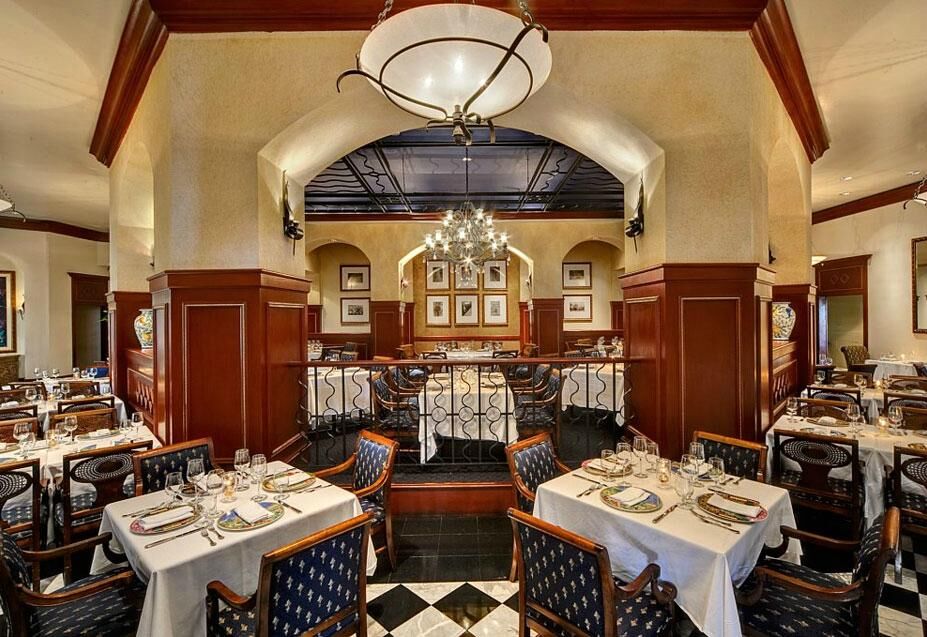
Located
on the ground floor of the east wing of the
hotel, this is an upscale steak and seafood
establishment, with white-clothed tables, good
china and stemware and friendly, professional
service. Starters include fresh spinach
and burrata salad, meaty jumbo crab
cakes and a seafood tower of bivalves and
crustaceans. Classic main courses run the gamut
from perfectly prepared prime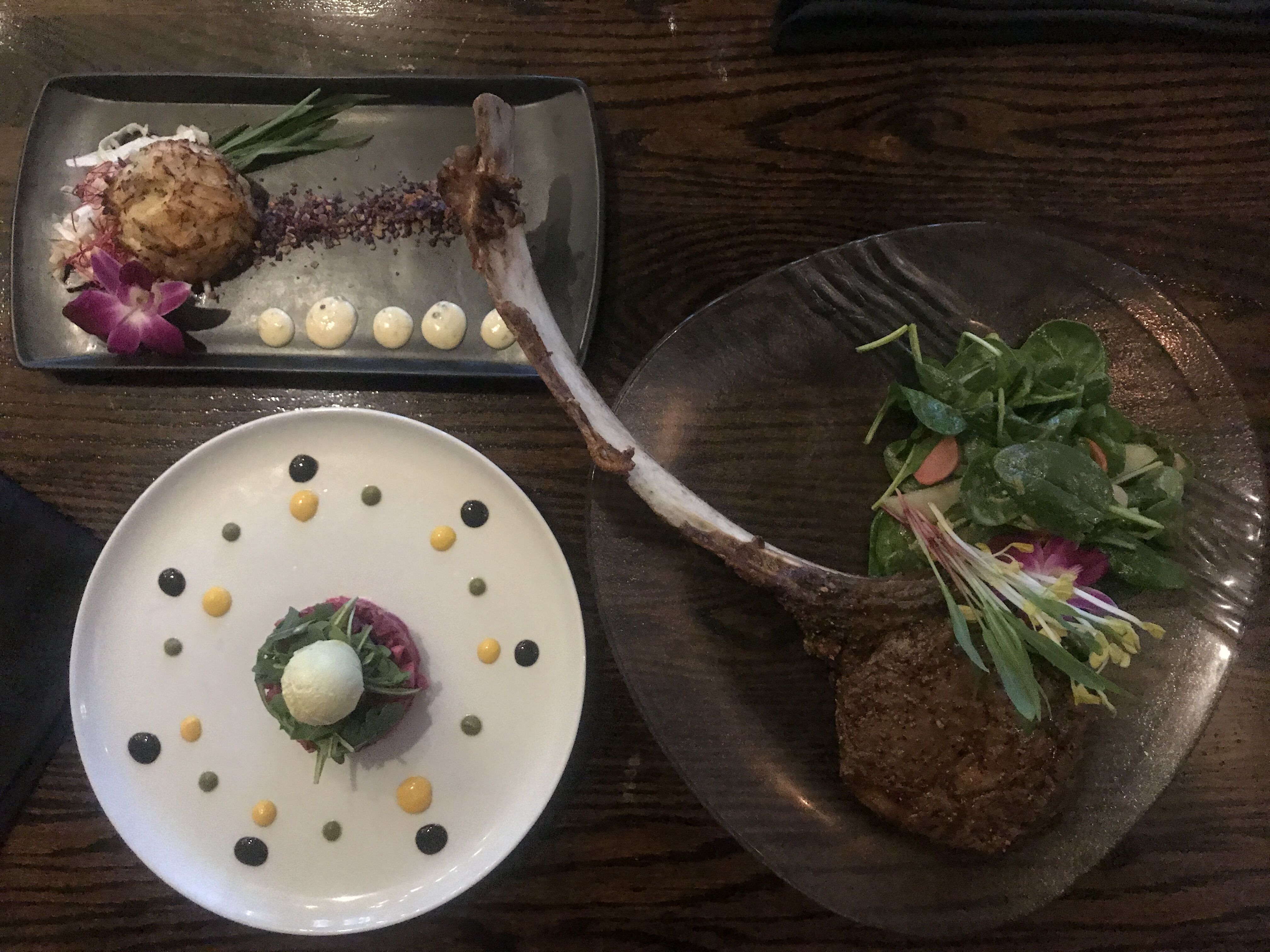 rib to a dry-aged New
York strip steak, from grilled or broiled whole
Caribbean lobster to sautéed jumbo gulf prawns
served with a flavorful onion and heirloom
tomato confit. Also available are the usual
steakhouse sides like creamed spinach, sautéed
mushrooms and baked potatoes.
rib to a dry-aged New
York strip steak, from grilled or broiled whole
Caribbean lobster to sautéed jumbo gulf prawns
served with a flavorful onion and heirloom
tomato confit. Also available are the usual
steakhouse sides like creamed spinach, sautéed
mushrooms and baked potatoes.
For wine
we chose a 2013 MUGA Reserva that showed rich
flavors of ripe plums and strawberries with a
hint of chocolate in its finish and we concluded
our meal with a honey-scented popcorn crème
brûlée.
Roots Coastal Kitchen
 This
very
casual spot, also located on the ground floor of
the hotel, features “build-your-own” gourmet
pizzas and burgers, as well as slow-roasted spare
ribs coated in a tangy guava barbecue sauce and a
whole deep-fried crispy snapper (for two) served
on a bed of crisp arugula topped with slices of
“flame throwing” peppers. And desserts like banana
bread accompanied by ice cream and a chocolate
peanut butter banana split are very popular.
This
very
casual spot, also located on the ground floor of
the hotel, features “build-your-own” gourmet
pizzas and burgers, as well as slow-roasted spare
ribs coated in a tangy guava barbecue sauce and a
whole deep-fried crispy snapper (for two) served
on a bed of crisp arugula topped with slices of
“flame throwing” peppers. And desserts like banana
bread accompanied by ice cream and a chocolate
peanut butter banana split are very popular.
Caicu Bar &
Tapas
As part of
the hotel's main lobby and providing
bar, table and outdoor seating, this casual spot
offers “bar bites,” ranging from shrimp tacos
topped with slaw and a spicy chipotle sauce to
tender shrimp bathed in a garlic-infused lobster
sauce to chicken potstickers served with pickled
ginger and a soy sauce enlivened by ponzu and sriracha. In
addition, there’s a salad of heirloom tomato and
baby spinach as well as one made of shaved
Brussels sprouts; large plates include a grilled
prime tenderloin and catch of the day.
For wine we chose a cassis- and
strawberry-flavored 2015 Hess Select North Coast
Cabernet Sauvignon that had notes of vanilla in
its finish and we concluded our meal with creamy
flan atop rich chocolate cake.
Expect dinner for two at any of the above restaurants to cost $110-$130 (perhaps a bit less at Roots), not including wine, tax and tip.
Rio Grande and
Loquillo
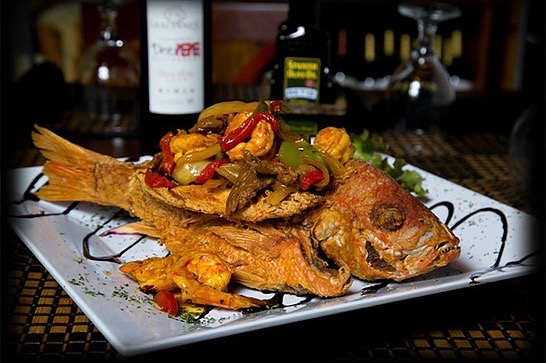 Don
Pepe
Don
Pepe
Highway #3
787-888-7373
This
small, unpretentious roadside storefront, just
down the road from the entrance of the Wyndham, is
a room with a bar on one side and a wall with
colorful local prints on the other. It offers
prompt, knowledgeable service with a large
selection of well-prepared Puerto Rican favorites.
We enjoyed appetizers of a tasty mix of fleshy
octopus and potato atop a basket of mofongo (fried
green
plantains) and a large portion of greaseless deep
fried chunks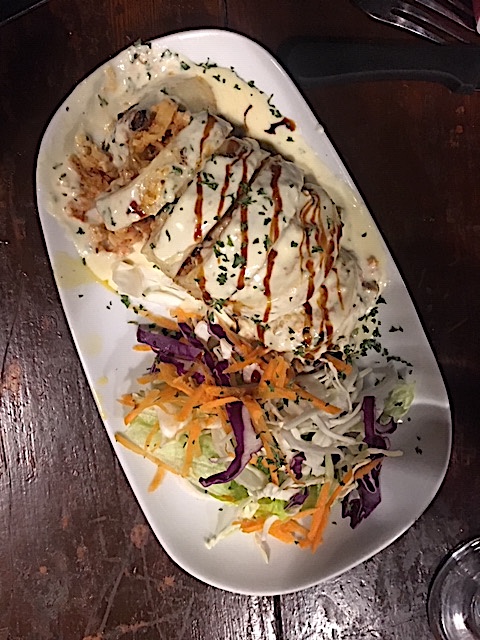 of fresh
grouper served with a variety of mild and spicy
sauces.
of fresh
grouper served with a variety of mild and spicy
sauces.
From over a
dozen main course choices we selected a whole
fried red snapper
(above)
stuffed with local lobster and an order of a trio
of garllicky, breaded shrimp on brochette
served with a mound of yellow rice and crisply
fried bits of pork.
We accompanied the meal with a
2010 easy drinking Don Pepe Rioja and concluded
with a slice of chocolate cake topped with vanilla
flan.
Open nightly for dinner. Expect dinner for two to cost $90-$100, excluding wine, tax and tip.
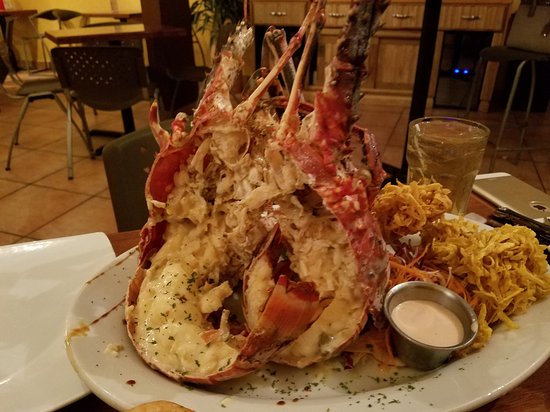 Terruno
Terruno
Kiosko #20,
Kioskos de Loquillo
787-889-8989
Located
in a large, nondescript space among a row of
“kiosks” along Loquillo beach, this locally
popular establishment serves Puerto Rican food
with an emphasis on seafare. From an extensive
selection of appetizers, we chose an order of
crisp, grilled octopus tentacles and one of a
large, tender squid stuffed with a tasty blend of
lobster bits and bread crumbs and coated with an
herb-infused cream sauce.
Our main courses were less
enjoyable. An order of langoustines came floating
in a rather gloppy tomato-based, Creole sauce,
while an order of whole Caribbean lobster was
overcooked and served with a bland garlic-butter
sauce.
Open nightly for dinner. Expect dinner for two to cost $110-$120, excluding wine, tax and tip.
A BIT OF GOLF
(at Wyndham’s Grand Rio Mar Country
Club)
Managed by Troon
Golf, both courses were in excellent condition,
with manageable rough and divot-free greens. And
while only one hole (the long par-3 16th) of the
45 year-old Ocean Course—par 71, 6,700 yards
from “the tips”—is actually on the ocean, it
offers an enjoyable experience for seasoned long
hitters as well as the average golfer. In fact,
designed by George Fazio, it has plenty of ponds
alongside the fairways as well as elevated
greens surrounded by sand traps to require
accuracy by all player levels. And, adding to
the experience, there’s lots of wildlife on and
alongside the course, like colorful iguanas and
birds ranging from herons, to egrets to wild
ducks. On the other hand, the River
Course—designed by Greg Norman and measuring
over 6,900 yards from “the tips”—features rather
narrow fairways and a number of forced carries
over water and marshy barancas, providing even
the best golfers a memorable, invigorating
experience.
Play on either course
is open to all, with an average daily fee of
$215 per 18-hole round. (Special rates are
available to Wyndham hotel guests and Troon
members.) 800-424-6627
❖❖❖
By John Mariani
85 Second Avenue (at the corner of 5th Street)
212-677-1030
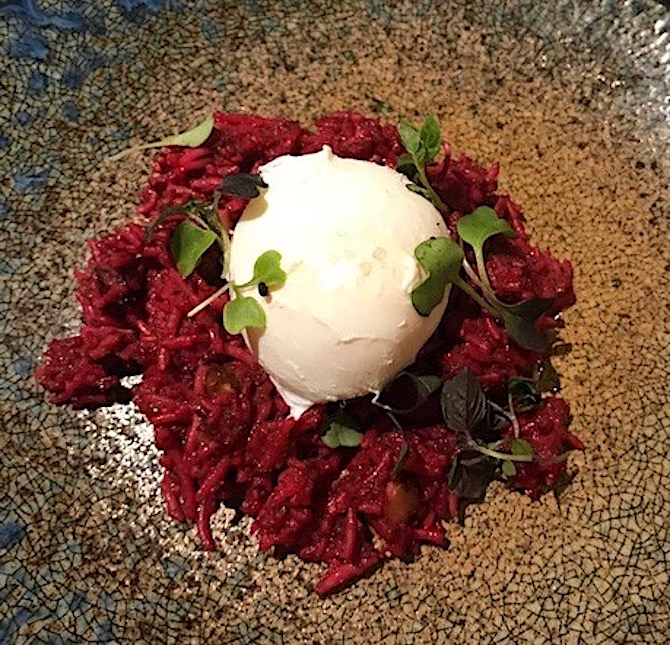
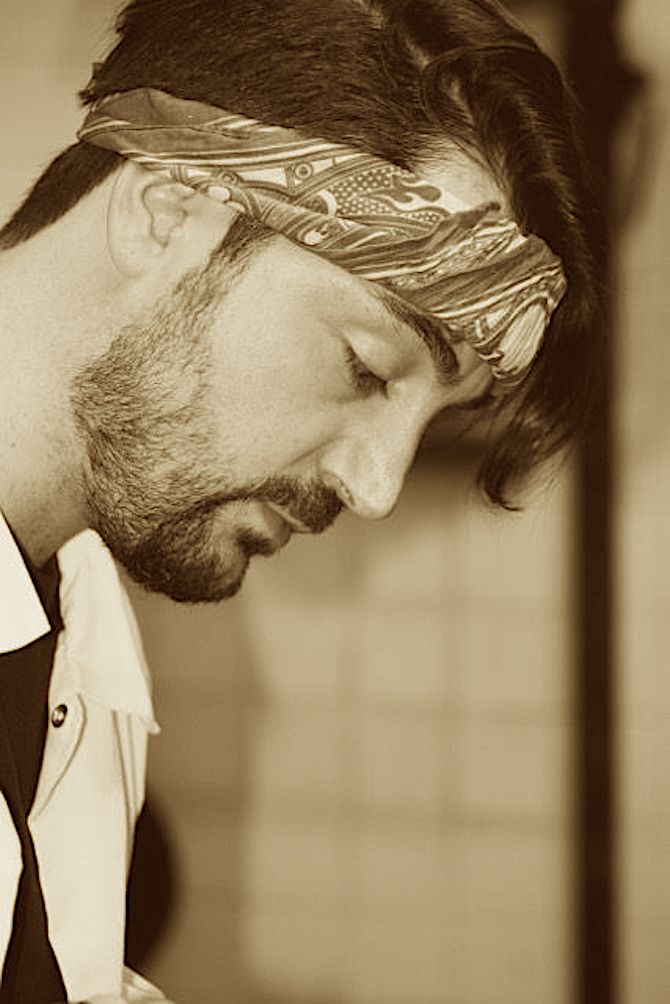 Rodriguez is from
Galicia, where nai
means “mother” in the local
dialect, and he credits his mother as being an
indelible influence, especially
from the days he cooked alongside her at her
restaurant Merendero Cave. He was
equally excited by the innovations made in
Spanish cuisine over the past
decade, not least in expanding the style and
variety of traditional tapas and
by using some of the more sensible modernist
techniques to create colorful
contrasts and unexpected combinations.
Rodriguez is from
Galicia, where nai
means “mother” in the local
dialect, and he credits his mother as being an
indelible influence, especially
from the days he cooked alongside her at her
restaurant Merendero Cave. He was
equally excited by the innovations made in
Spanish cuisine over the past
decade, not least in expanding the style and
variety of traditional tapas and
by using some of the more sensible modernist
techniques to create colorful
contrasts and unexpected combinations.
Operations and Wine
Director Raul Oleaga, who’d
worked with master chef Sergi Arola in Madrid,
is an energetic and congenial
host, so trust whatever he suggests for wine
pairings from an all-Spanish list
of contemporary labels at good prices.
They also serve excellent white and red
sangria.
The menu is divided into Tapas Modernas and Tapas
Traditionales, and the best course of
action is to let Rodriguez send out
plate after plate, which changes all the time,
for you to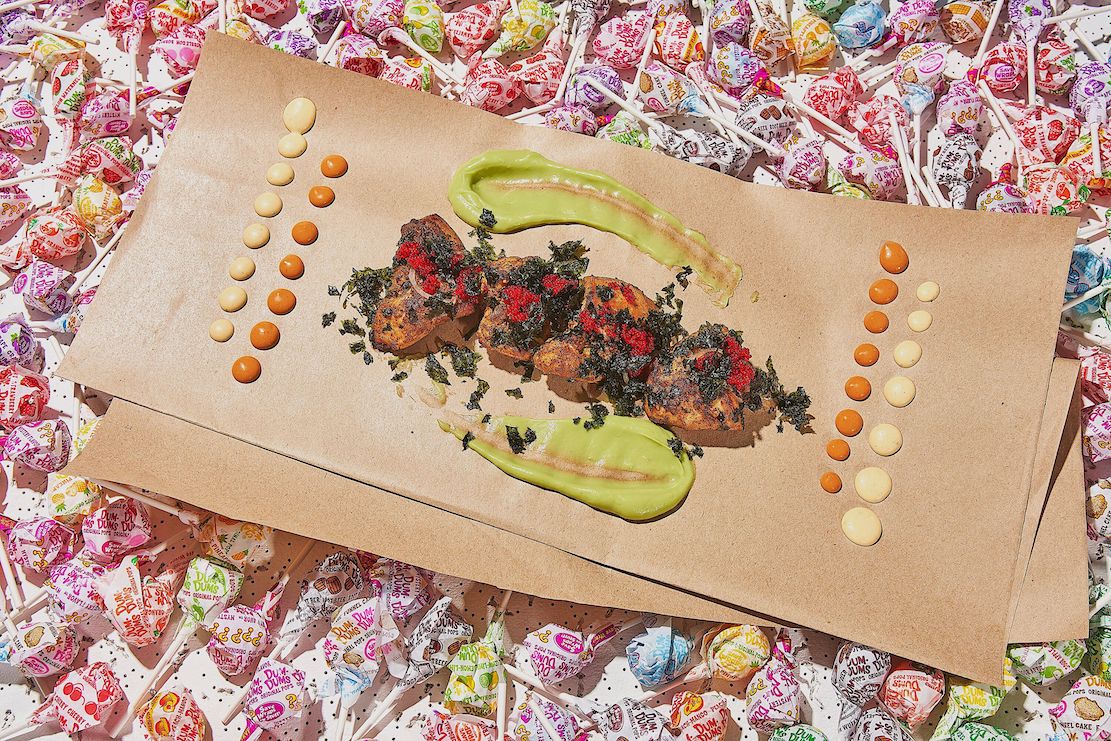 marvel at until you
cry, “No
mas!”
The tasting menu is $89 with sangria,
$110 with selected wines.
marvel at until you
cry, “No
mas!”
The tasting menu is $89 with sangria,
$110 with selected wines.
You might begin with a
traditional dish of almejas à
la brasa, broiled clams with
lemon zest, cilantro and yuzu.
Far
more adventurous is a suquet,
a
Catalan seafood stew of monkfish and
langoustine in a cockle fumet with Marcona
almond picada
sauce.
You don’t see much salmon on menus in
Spain, but Rodriguez does a delightful turn
with the fish, cutting it
sashimi-like, with saffron and a garlic aïoli
and seared in a brûlée treatment
that makes its flesh creamier. Chilean sea
bass comes with 12-months aged
Serrano ham,
heirloom asparagus, a
sweet-sour orange emulsion and
saffron-colored sea salt flakes.
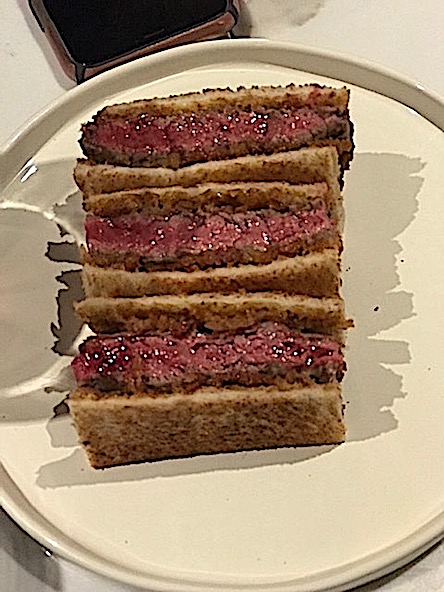 Clearly
Rodriguez has moved far beyond the
dozen or so classic tapas offered at every bar
in Spain. He borrows the idea of
ramen noodles—not radically different from
Spanish fideuà—and gives it a Galician
twist in a Savoy cabbage broth with
alubia beans and semi-cured smoky paprika
chorizo for ballast and heat.
Clearly
Rodriguez has moved far beyond the
dozen or so classic tapas offered at every bar
in Spain. He borrows the idea of
ramen noodles—not radically different from
Spanish fideuà—and gives it a Galician
twist in a Savoy cabbage broth with
alubia beans and semi-cured smoky paprika
chorizo for ballast and heat.
Borrowing from Japan is nori-wrapped manchego cheese
with beet-colored basmati rice and
Portobello mushroom slices marinated in
truffle oil—an exquisitely beautiful
dish of great flavor and texture. So, too, the
idea of breaded katsu-style
ribeye in a beer batter
takes on the spice of sweet-hot peppers (left),
while chicken is enhanced with poblano
peppers, an avocado puree and
chipotle aïoli.
You then cool down the
palate with watermelon
and seasonal desserts.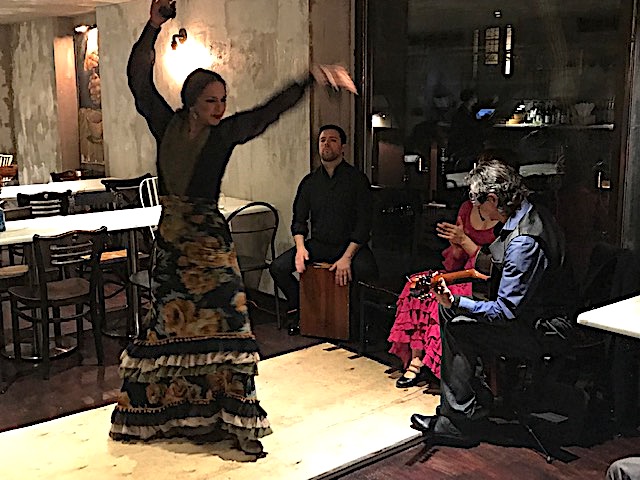
The bi-level interior has a
rustic cast, with
raw cement walls minimally enlivened with
artwork, vintage food containers and
a series of portraits on glass of Ruben’s
family. When the downstairs bar is
crowded, it can be crashingly loud, but
upstairs it is less so, except on the
wonderful nights—Thursdays and Saturdays—when
they have flamenco musicians and
dancers, who make this a very special place
indeed. The flash and color, the
brisk strumming on the guitar and the clacking
of the castanets heighten all
the sensory pleasures of the food and drink at
the tables.
(Two shows each night.)
The New
York area is blessed to have three of
the very finest Spanish chefs and restaurantes
in America—Luis Bolo of Santina on Ninth
Avenue, Ignacio Blanco of Ibiza in
Chappaqua, N.Y., and Ruben Rodriguez at Nai,
each, in very personalized ways,
at the forefront of Spanish cuisine in the
21st century.
And for further enticement and a sense
of being truly in Spain, Nai brings the added
spirit and passion of flamenco.
Open daily for lunch and dinner.
❖❖❖
By John Mariani
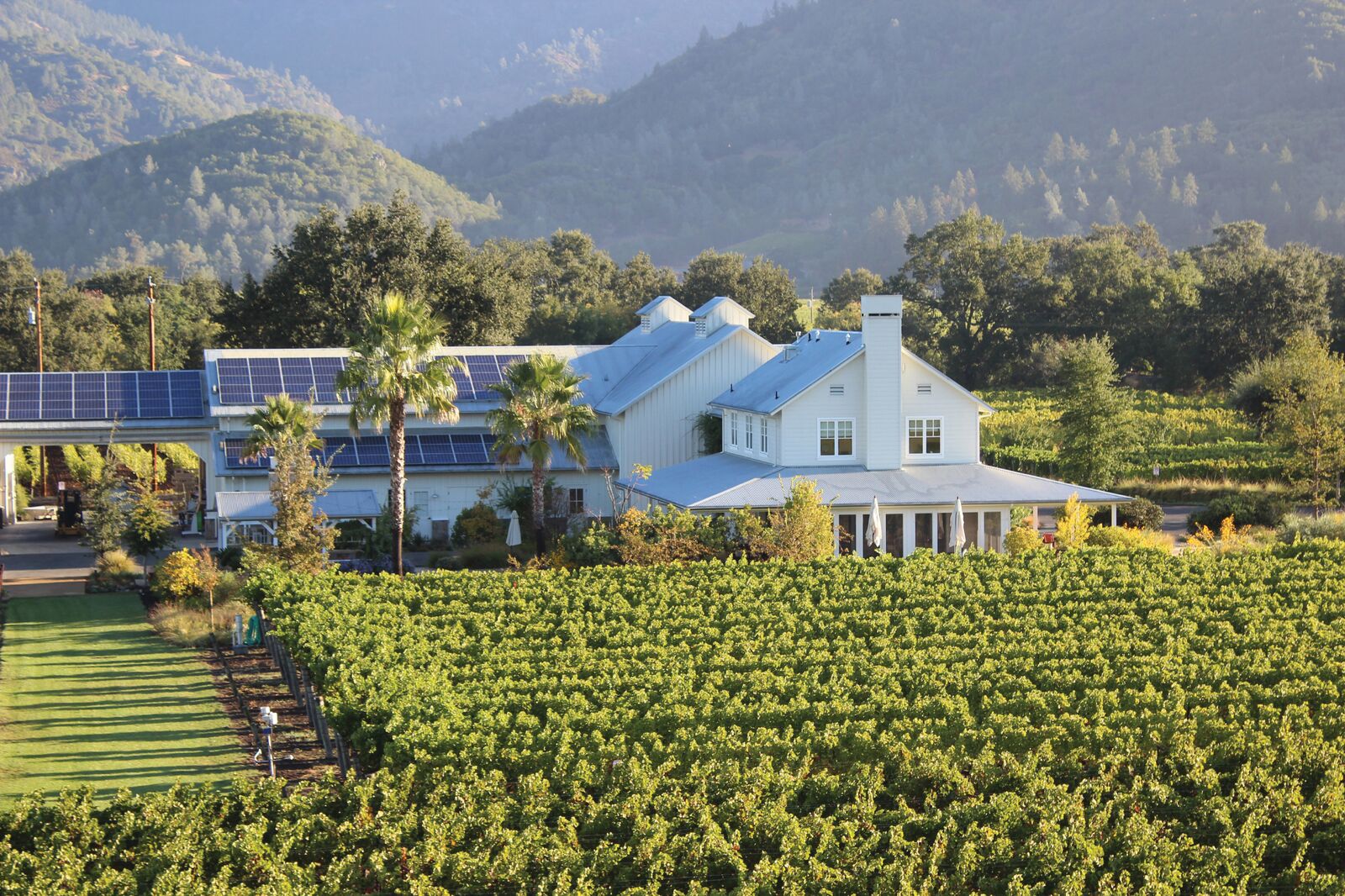
Winemakers come in different
shapes, sizes and sexes, but all share a passion
for what they do—turning grapes into a wonderful
beverage. In the case of Dan Petroski, winemaker
at Napa Valley’s Larkmead Vineyards, he is of a
tall, large size, bearded and looking like he’d
be a good choice for a Judd Apatow comedy as a
sidekick to Seth Rogan.
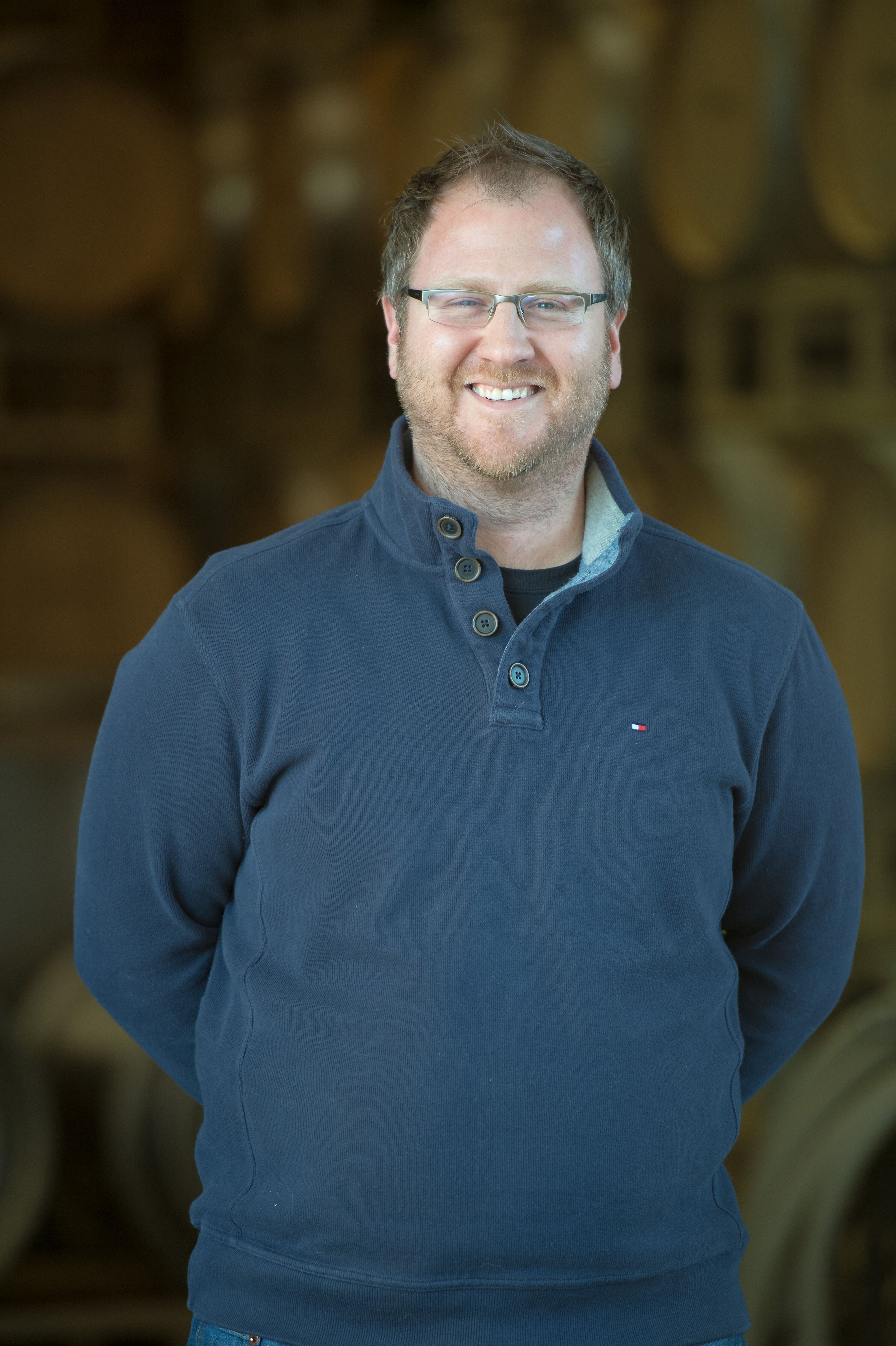 Petroski (left) met me
for dinner at New York’s Union Square Café and,
despite just having come from a prodigious
industry wine exhibition, he bounded into the
dining room, immediately ordered a martini (I
drank a daiquiri) followed by dinner for four of
us with three bottles of Larkmead Cabernet
Sauvignons. Then he was off to have a drink with a
friend uptown—the true image of the passionate
gourmand.
Petroski (left) met me
for dinner at New York’s Union Square Café and,
despite just having come from a prodigious
industry wine exhibition, he bounded into the
dining room, immediately ordered a martini (I
drank a daiquiri) followed by dinner for four of
us with three bottles of Larkmead Cabernet
Sauvignons. Then he was off to have a drink with a
friend uptown—the true image of the passionate
gourmand.
Petroski arrived at Larkmead,
which is considered one of the most prestigious
and priciest wineries, by a circuitous route. Born
and bred in Brooklyn, he attended Columbia
University, where he played football, got his MBA
from NYU, then worked at Time Inc. managing
advertising clients, a job that required expense
account meals at New York’s finest restaurants on
a regular basis—this at a time when magazines were
flush. He recalled one night dining with Time
Inc.’s publisher, who blew $4,000 at the
wine-centric restaurant Veritas. But the evening
that changed his life, as well as his career
plans, was at the French seafood restaurant Le
Bernardin in 1999.
“We were drinking Sean
Thackrey’s Pleiades,” he said, “and it completely
blew me away. I begged to get on his mailing list,
and I was hooked on fine wines, especially the
romance surrounding them. For me, great wines
always have romantic vignettes attached to them,
not just technical stats and chemical analysis.”
The result of that evening was
his moment of falling in thrall to great wine.
Five years later Petroski turned down an offer to
work at the Wall
Street Journal in favor of moving to Sicily
for a year, where he interned at Valle dell’Acate,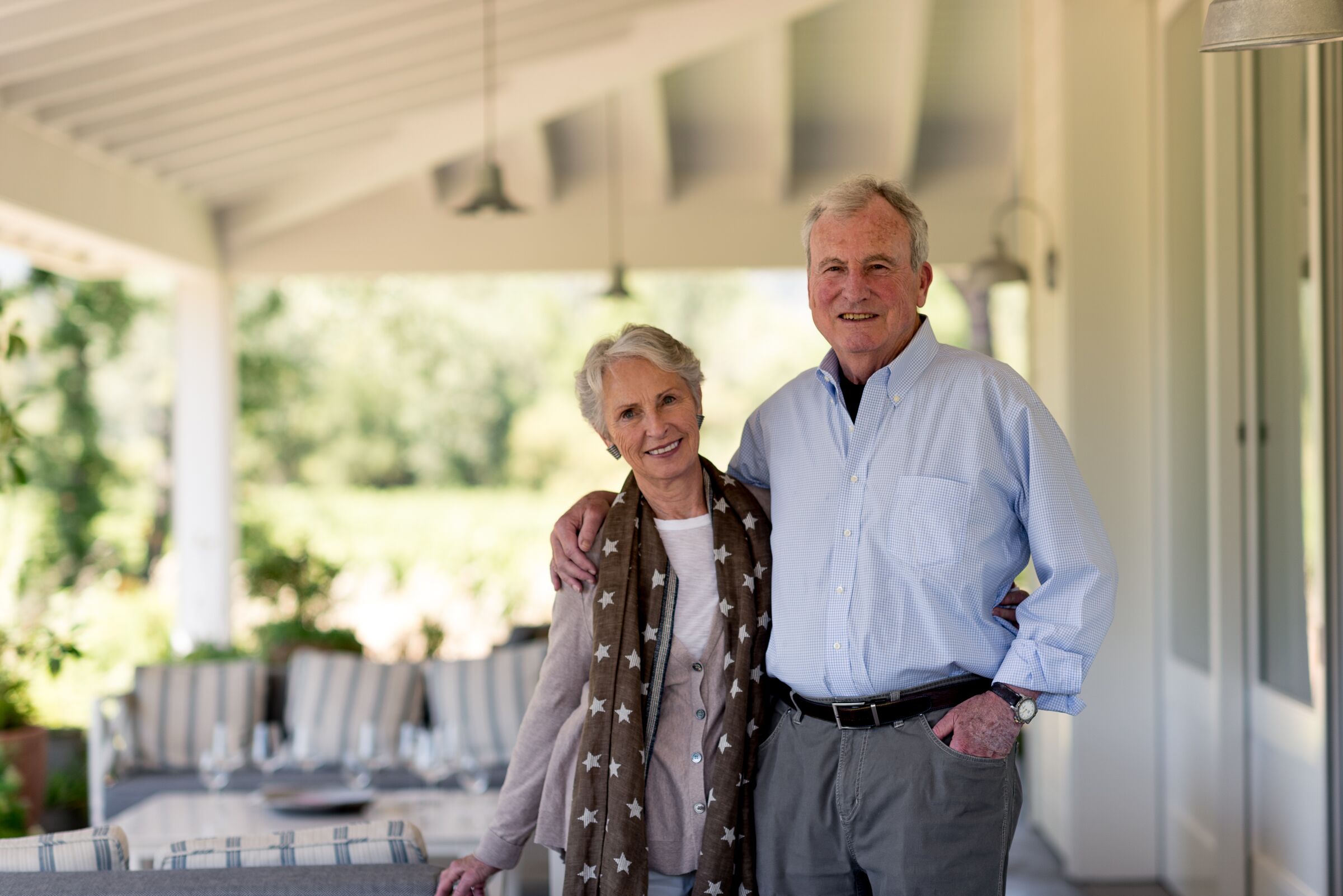 then returned to the
U.S. to work for Andy Smith at DuMOL Winery in
Sonoma Valley for the 2006 harvest. Smith
thereupon offered him the job of cellar master at
Larkmead and by 2012 he’d been appointed
winemaker. In 2017 the San Francisco
Chronicle dubbed him Winemaker of the Year.
then returned to the
U.S. to work for Andy Smith at DuMOL Winery in
Sonoma Valley for the 2006 harvest. Smith
thereupon offered him the job of cellar master at
Larkmead and by 2012 he’d been appointed
winemaker. In 2017 the San Francisco
Chronicle dubbed him Winemaker of the Year.
Petroski, now 46, is especially
known for big, muscular Cabernet Sauvignons at
Larkmead, which is owned by Cam Baker and his
wife, Kate Solari (right), who revived the
vineyards as of 1995—a century after Larkmead was
founded—now encompassing 110 acres of vines in
southern Calistoga.
Over a meal of pasta and pancetta
and a massive ribeye, Petroski spoke of
California’s “Golden Age of Wine” being 2000 to
2010. “It’s the time we really changed the way
wine is bought, sold and enjoyed by 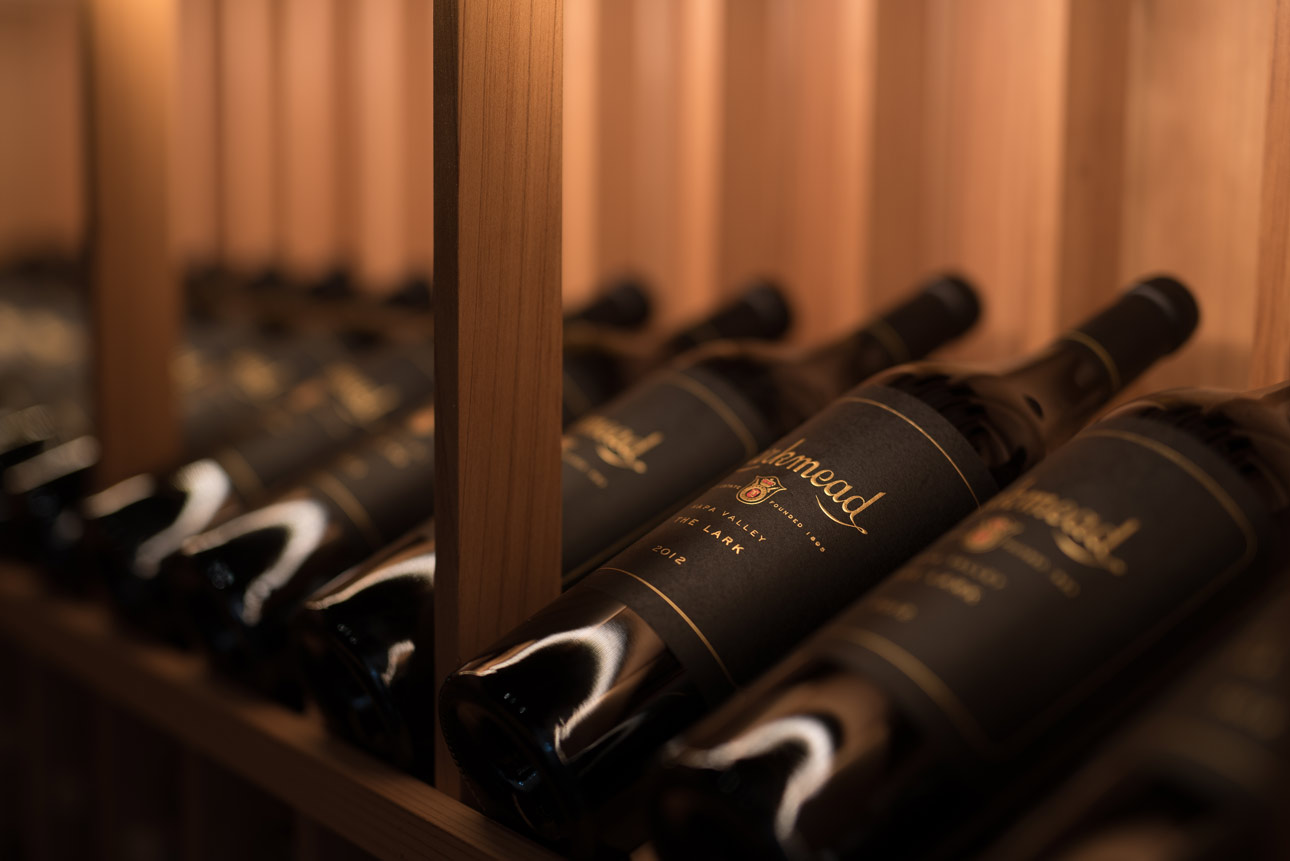 Americans. The wineries
opened some pretty impressive, beautiful tasting
rooms, where people could buy the wines or have
them shipped home. You can stop by a chateau in
Bordeaux, but you have to load the cartons of
wines into your trunk. We also have our mailing
lists for our faithful customers.”
Americans. The wineries
opened some pretty impressive, beautiful tasting
rooms, where people could buy the wines or have
them shipped home. You can stop by a chateau in
Bordeaux, but you have to load the cartons of
wines into your trunk. We also have our mailing
lists for our faithful customers.”
At Larkmead, the tasting room
is open daily, with tastings at $75 to $90,
“depending on the experience.” Memberships range
from a guarantee of 10 to 12 bottles per year at
$1,400-$1,500; 20 to 24 bottles at $2,800-$3,000;
and 30 to 36 bottles for $4,200-$4,500. Some
wines, like The Lark, are allocated.
None of Larkmead’s wines are
made in large supply. Only 3,029 cases were made
of the 2016 Cabernet Sauvignon ($120), made from
94% Cab and 6% Petit Verdot, aged for 19 months.
The 100% Cabernet Dr. Olmo 2013 ($180) production
was only 1,635 cases, aged for 17 months; and the
100% Cabernet Solare 2015 ($240) only 565 cases.
(Consider that Petroski’s favorite Bordeaux,
Château Haut-Brion, produces about 9,000 cases
annually.)
These were all deliciously bold
Cabs, unquestionably in the brawny 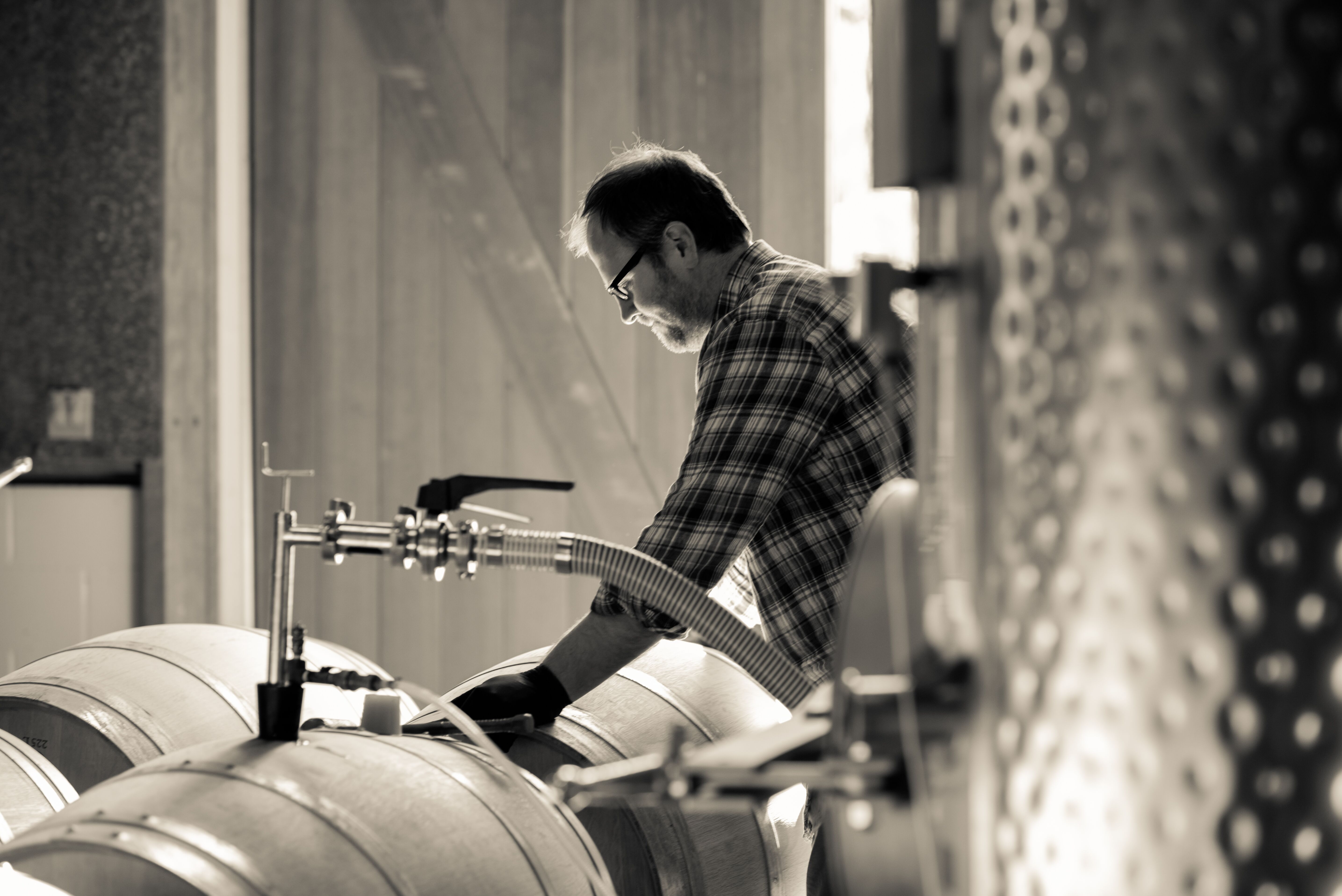 Napa Valley style, but
their complexity and spice kept giving up more
flavors as they mingled with the ribeye’s, with
tannins already softened up.
Napa Valley style, but
their complexity and spice kept giving up more
flavors as they mingled with the ribeye’s, with
tannins already softened up.
My tolerance for high alcohol
stops at 14.5%, but though these were 14.7%,
probably higher, by meal’s end they still showed
finesse over mere power.
As I do whenever I
speak to winemakers, I asked about the effects of
global warming on the wine industry in California.
“It’s very real,” he said, “and
we in Napa and Sonoma have problems with drought
and now chronic wildfires. If I had to guess, I’d
say that within the next 20 to 30 years the
industry and the vineyards will have to shift 250
miles to the north, where it will be cool enough
to grow wine grapes.” Which, I calculate, would
put them just south of the Redwoods National
Forest, where temperatures currently range from 40
to 80 degrees through the year.
Knowing Petroski, I imagine him
pulling up stakes whenever he gets a great notion
and go wherever he thinks he can make better
wines. I’ll check back with him in twenty years.
 MUCKRAKING
JOURNALISM 2019
MUCKRAKING
JOURNALISM 2019
Chicago Tribune food editor Joe Gray promised, "In 2019 and beyond, the Tribune food team will laser-focus on sometimes-overlooked neighborhoods, where the culture and history that produced specific foods is largely unknown to a larger public. A beautiful example of this is Nick Kindelsperger’s investigative work on the peppermint stick-in-the-pickle snack, a street treat that really does exist."--"Big Heat 2019: Chicago’s Food and Drink 50," Chicago Tribune (2/28/19)
 AND NEXT YEAR'S OSCARS WILL
AND NEXT YEAR'S OSCARS WILL 
BE HOSTED BY GUY FIERI
The James Beard Foundation has chosen model Tyra Banks
to host its Media awards in May.
Wine
Column Sponsored by Banfi Vintners
SANGIOVESE
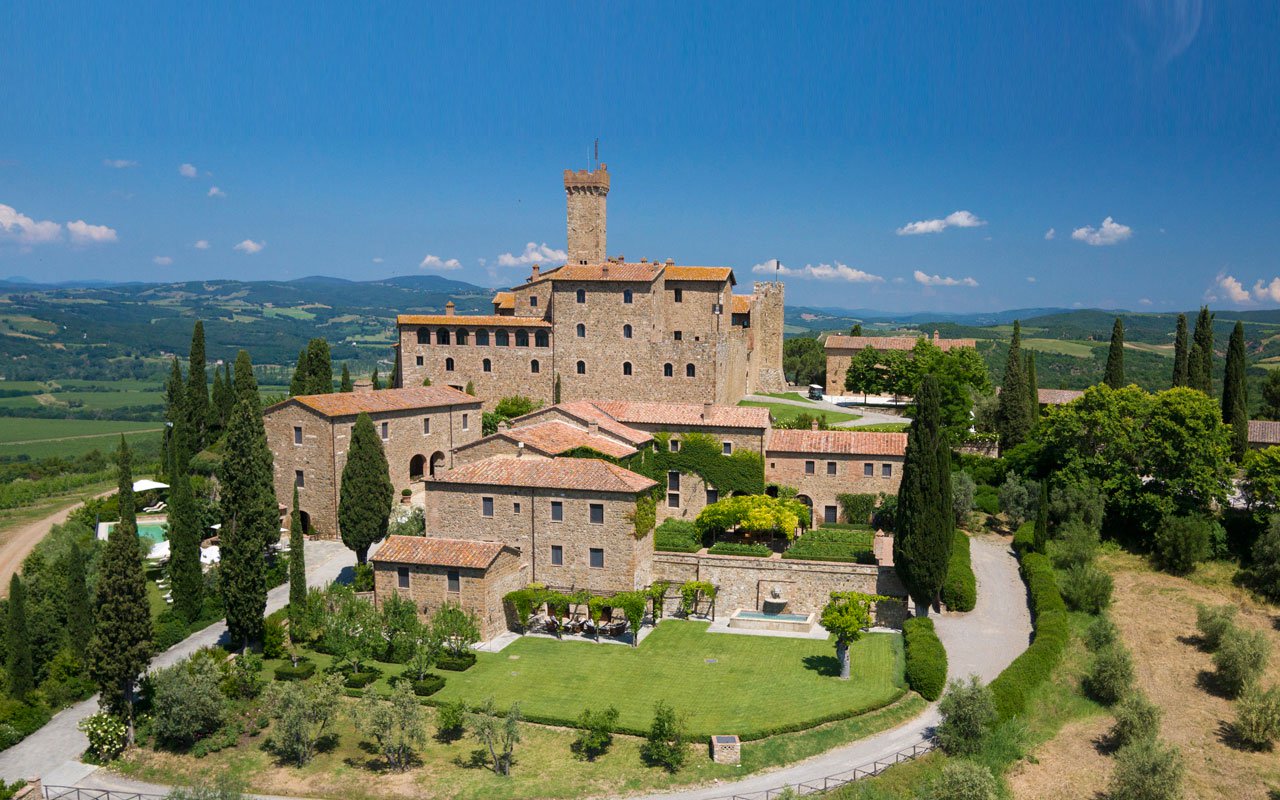 Wine is a joy year-round but
in cooler weather one
grape varietal has really taken center stage in
my daily activities – that most Italian of
grapes, Sangiovese, and its ultimate expression
– Brunello di Montalcino.
Wine is a joy year-round but
in cooler weather one
grape varietal has really taken center stage in
my daily activities – that most Italian of
grapes, Sangiovese, and its ultimate expression
– Brunello di Montalcino.
From mid-September through mid-October,
the Sangiovese grown for our various styles of red
wines are be harvested, culminating with the top
selection for Brunello di Montalcino.
Second, cooler weather here means
it is time to start enjoying more red wines and
especially Sangiovese based wines. That
includes Banfi’s cru of Brunello, Poggio alle Mura,
literally the cream of the crop of our Sangiovese
vineyards. Alongside our Poggio alle Mura Brunello di
Montalcino, this year we introduced two more wines
from the cru Poggio alle Mura – a Rosso di Montalcino
and a Riserva of Brunello. Rosso is sort of like the
younger brother of Brunello, also made from 100%
Sangiovese grapes but usually a selection from younger
vines and the wine is aged only two years compared to
the four required for Brunello. The
Riserva, on the other hand, is an even more selective
harvest of Sangiovese, and ages for an additional year
before release.
What is so special about this cru
Poggio alle Mura?
Well, it is the result our over 30 years of
ongoing research at my family’s vineyard estate,
Castello Banfi.
When we first began planting our vines there in
the late 1970s studies from the University of Bordeaux
indicated which strains of many varietals we should
plant, based on the soil type and microclimate of each
vineyard. But
when it came to the region’s native Sangiovese, there
was only local lore, no scientific research. So we took
it upon ourselves to figure out this vine, and set off
on three decades of incredibly detailed research.
We started
with 600 apparent variations on Sangiovese, because it
is so susceptible to variations in weather and soil,
and narrowed that down to 160 truly genetically
different clones.
We planted a vineyard with two rows of each
type, made wine from each of them, and charted the
differences – remember, you only get one chance a year
to make wine, so this took time.
It took about ten years to get some
concrete results, though we continue to experiment
today and always will – you never stop learning in
science and nature!
Once we determined which were the best,
complementary clones that could be planted together to
make the best Brunello, we chose to plant them in what
we determined to be the optimal vineyard sites. Coincidentally,
the best soils and climate conditions are in the
slopes surrounding the medieval fortress today known
as Castello Banfi, known since Etruscan times as
Poggio alle Mura – the walled hilltop. Hence the
name of our most special “cru” of Brunello,
representing a synthesis between tradition and
innovation.
Though the focus of this study was
our Brunello, all of our Sangiovese-based wines,
including the super Tuscans SummuS, Cum Laude, and
Centine, benefitted from this work. And that’s
the third reason for celebrating Sangiovese this
month, for the range of wonderful reds that usher us
into autumn! One
wine in particular was inspired by our research – the
BelnerO, a Sangiovese dominant blend with what I like
to call a kiss of Cabernet and a whisper of Merlot. We grow the
grapes a little differently for BelnerO than for
Brunello, make the wine with less oak aging and
released it earlier from the winery, providing a
counterpoint to Brunello and a lovely terroir-driven
wine in its own right.
If you
know Italians, you know that by nature we are
multi-faceted, varying in mood, and always passionate. As a
nation, we span from the hot sunny beaches of Sicily
near the African coast to the rugged mountains and
Alpine ski slopes of Trentino-Alto Adige in the north. Sangiovese
is grown in almost all of Italy’s regions and reflects
the unique nature of each; it is most famous
(rightfully so) in Tuscany, yet even there it reflects
the nuances of each hilltop, valley and subzone. It has
something a little different to say in Brunello than
Chianti, Morellino than Vino Nobile di Montepulciano,
Rosso di Montalcino than Super Tuscan blends.
Here is a smattering of
Sangiovese-based wines that you may wish to get to
know better, reflecting a spectrum that appeals to
every occasion, every taste, and every budget. We can
assure you that the conversation will never become
boring. 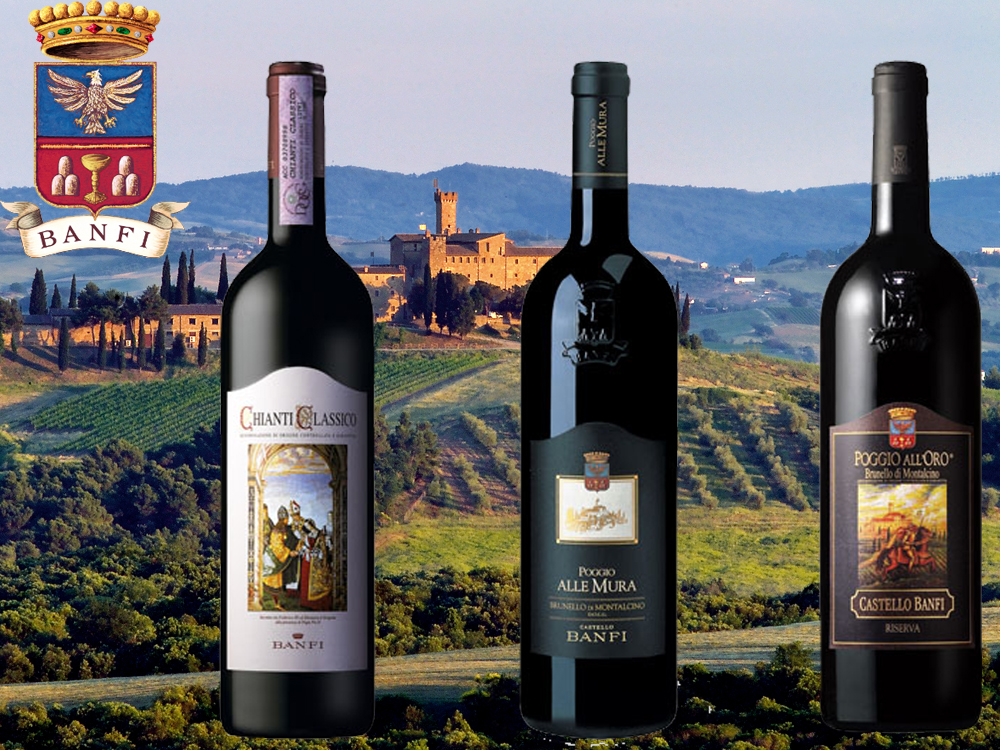
Recommendations for Celebrating
Sangiovese
BelnerO Proprietor’s Reserve Sangiovese
– A refined
cuvée of noble red grapes perfected by our pioneering
clonal research. This dark beauty, BelnerO, is
produced at our innovative winery, chosen 11
consecutive years as Italy’s Premier Vineyard Estate.
Fermented in our patented temperature controlled
French oak and aged approximately 2 additional years.
Unfiltered, and Nitrogen bottled to minimize sulfites.
Castello Banfi Brunello di Montalcino –
Rich, round, velvety and intensely
aromatic, with flavor hints of licorice, cherry, and
spices. Brunello di Montalcino possesses an intense
ruby-red color, and a depth, complexity and opulence
that is softened by an elegant, lingering aftertaste.
Unfiltered after 1998 vintage.
Castello Banfi Rosso di Montalcino – Brunello's "younger brother," produced
from select Sangiovese grapes and aged in barrique for
10 to 12 months. Deep ruby-red, elegant, vibrant,
well-balanced and stylish with a dry velvety
finish.
Poggio all’Oro Brunello di Montalcino
Riserva – A single vineyard selection of our most
historically outstanding Sangiovese, aged five years
before release, the additional year more than that
required of Brunello including 6 months in barrel and
6 months more in bottle to grant its “Riserva”
designation. Incredible
elegance and harmony. Intense with lots of fruit and
subtle wood influence. Round, complete, well balanced
with hints of chocolate and berries. Unfiltered after
1998.
Poggio alle Mura – The first tangible result of years of
intensive clonal research on Montalcino’s native
Sangiovese grape.
Estate bottled from the splendidly sun drenched
vineyards surrounding the medieval Castello from which
it takes its name.
The Brunello
di Montalcino is seductive, silky and smoky. Deep ruby
in color with an expressive bouquet of violets, fruits
and berries as well as cigar box, cedar and exotic
spices. The Rosso
di Montalcino is also intense ruby red. The bouquet
is fresh and fruity with typical varietal notes of
cherry and blackberry, enriched by more complex hints
of licorice, tobacco and hazelnut. It is full
bodied, yet with a soft structure, and a surprisingly
long finish. The Poggio alle Mura Brunello di Montalcino
Riserva is deep ruby red with garnet
reflections and a rich, ample bouquet that hints of
prune jam, coffee, cacao and a light balsamic note. It is full
and powerful, with ripe and gentle tannins that make
it velvety and harmonious; this wine is supported by a
pleasing minerality that to me speaks soundly of that
special hillside in southern Montalcino.
SummuS – A wine of towering elegance, SummuS is an
extraordinary blend of Sangiovese which contributes
body; Cabernet Sauvignon for fruit and structure; and
Syrah for elegance, character and a fruity bouquet. An elegant,
complex and harmonious red wine.
Cum Laude – A complex and elegant red which graduated
“With Honors,” characterized by aromas of juicy
berries and fresh spices.
Centine – A Cuvee that is more than half
Sangiovese, the balanced consisting of equal parts of
Cabernet Sauvignon and Merlot. Vinified in
a firm, round style that easily accompanies a wide
range of dishes, this is a smooth and fragrantly
satisfying wine with international character, and a
perennial favorite at my own dinner table.
Banfi Chianti Superiore – The “Superiore” designation signifies
stricter government regulations regarding production
and aging requirements, as compared to regular
Chianti. An
intense ruby red wine with fruit forward aromas and
floral notes. This
is a round wine with well-balanced acidity and fruit.
Banfi Chianti Classico – An enduring classic: alluring
bouquet of black fruit and violets; rich flavors of
cherry and leather; supple tannins and good acidity
for dining.
Banfi Chianti Classico Riserva – Produced from select grapes grown in the
"Classico" region of Chianti, this dry, fruity and
well-balanced red has a full bouquet reminiscent of
violets.
Fonte alla Selva Chianti Classico – This is our newest entry into the Chianti
arena, coming from a 99 acre estate in Castellina, the
heart of the Chianti Classico region. The wine is
a captivating mauve red that smells of cherry, plum
and blackberry with hints of spice. It is
round, full and balanced with very good
acidity.
Col di Sasso – Sangiovese and Cabernet Sauvignon. Luscious,
complex and soft with persistent notes of fruit and
great Italian style structure.
Any of John Mariani's books below may be ordered from amazon.com.
 The Hound in Heaven
(21st Century Lion Books) is a novella, and
for anyone who loves dogs, Christmas, romance,
inspiration, even the supernatural, I hope you'll find
this to be a treasured favorite. The story
concerns how, after a New England teacher, his wife and
their two daughters adopt a stray puppy found in their
barn in northern Maine, their lives seem full of promise.
But when tragedy strikes, their wonderful dog Lazarus and
the spirit of Christmas are the only things that may bring
his master back from the edge of despair.
The Hound in Heaven
(21st Century Lion Books) is a novella, and
for anyone who loves dogs, Christmas, romance,
inspiration, even the supernatural, I hope you'll find
this to be a treasured favorite. The story
concerns how, after a New England teacher, his wife and
their two daughters adopt a stray puppy found in their
barn in northern Maine, their lives seem full of promise.
But when tragedy strikes, their wonderful dog Lazarus and
the spirit of Christmas are the only things that may bring
his master back from the edge of despair. WATCH THE VIDEO!
“What a huge surprise turn this story took! I was completely stunned! I truly enjoyed this book and its message.” – Actress Ali MacGraw
“He had me at Page One. The amount of heart, human insight, soul searching, and deft literary strength that John Mariani pours into this airtight novella is vertigo-inducing. Perhaps ‘wow’ would be the best comment.” – James Dalessandro, author of Bohemian Heart and 1906.
“John Mariani’s Hound in Heaven starts with a well-painted portrayal of an American family, along with the requisite dog. A surprise event flips the action of the novel and captures us for a voyage leading to a hopeful and heart-warming message. A page turning, one sitting read, it’s the perfect antidote for the winter and promotion of holiday celebration.” – Ann Pearlman, author of The Christmas Cookie Club and A Gift for my Sister.
“John Mariani’s concise, achingly beautiful novella pulls a literary rabbit out of a hat – a mash-up of the cosmic and the intimate, the tragic and the heart-warming – a Christmas tale for all ages, and all faiths. Read it to your children, read it to yourself… but read it. Early and often. Highly recommended.” – Jay Bonansinga, New York Times bestselling author of Pinkerton’s War, The Sinking of The Eastland, and The Walking Dead: The Road To Woodbury.
“Amazing things happen when you open your heart to an animal. The Hound in Heaven delivers a powerful story of healing that is forged in the spiritual relationship between a man and his best friend. The book brings a message of hope that can enrich our images of family, love, and loss.” – Dr. Barbara Royal, author of The Royal Treatment.
 |
The Encyclopedia of American Food and Drink by John F. Mariani (Bloomsbury USA, $35) Modesty forbids me to praise my own new book, but let me proudly say that it is an extensive revision of the 4th edition that appeared more than a decade ago, before locavores, molecular cuisine, modernist cuisine, the Food Network and so much more, now included. Word origins have been completely updated, as have per capita consumption and production stats. Most important, for the first time since publication in the 1980s, the book includes more than 100 biographies of Americans who have changed the way we cook, eat and drink -- from Fannie Farmer and Julia Child to Robert Mondavi and Thomas Keller. "This book is amazing! It has entries for everything from `abalone' to `zwieback,' plus more than 500 recipes for classic American dishes and drinks."--Devra First, The Boston Globe. "Much needed in any kitchen library."--Bon Appetit. |
"Eating Italian will never be the same after reading John Mariani's entertaining and savory gastronomical history of the cuisine of Italy and how it won over appetites worldwide. . . . This book is such a tasteful narrative that it will literally make you hungry for Italian food and arouse your appetite for gastronomical history."--Don Oldenburg, USA Today. "Italian
restaurants--some good, some glitzy--far
outnumber their French rivals. Many of
these establishments are zestfully described
in How Italian Food Conquered the World, an
entertaining and fact-filled chronicle by
food-and-wine correspondent John F.
Mariani."--Aram Bakshian Jr., Wall Street
Journal.
"Equal parts
history, sociology, gastronomy, and just
plain fun, How Italian Food Conquered the
World tells the captivating and delicious
story of the (let's face it) everybody's
favorite cuisine with clarity, verve and
more than one surprise."--Colman Andrews,
editorial director of The Daily
Meal.com. "A fantastic and fascinating
read, covering everything from the influence
of Venice's spice trade to the impact of
Italian immigrants in America and the
evolution of alta cucina. This book will
serve as a terrific resource to anyone
interested in the real story of Italian
food."--Mary Ann Esposito, host of PBS-TV's
Ciao
Italia. "John Mariani has written the
definitive history of how Italians won their
way into our hearts, minds, and
stomachs. It's a story of pleasure over
pomp and taste over technique."--Danny Meyer,
owner of NYC restaurants Union Square
Cafe, The Modern, and Maialino.
|
 |
 |
 |
 |
 |
 |
 |
 |
 Everett Potter's Travel Report:
Everett Potter's Travel Report: 
 Eating Las Vegas
JOHN CURTAS has been covering the Las Vegas
food and restaurant scene since 1995. He is
the co-author of EATING LAS VEGAS – The 50
Essential Restaurants (as well as
the author of the Eating Las Vegas web site: www.eatinglasvegas.
He can also be seen every Friday morning as
the “resident foodie” for Wake Up With the
Wagners on KSNV TV (NBC) Channel 3 in
Las Vegas.
Eating Las Vegas
JOHN CURTAS has been covering the Las Vegas
food and restaurant scene since 1995. He is
the co-author of EATING LAS VEGAS – The 50
Essential Restaurants (as well as
the author of the Eating Las Vegas web site: www.eatinglasvegas.
He can also be seen every Friday morning as
the “resident foodie” for Wake Up With the
Wagners on KSNV TV (NBC) Channel 3 in
Las Vegas.
MARIANI'S VIRTUAL GOURMET
NEWSLETTER is published weekly. Publisher: John Mariani. Editor: Walter Bagley. Contributing Writers: Christopher Mariani,
Robert Mariani, Misha Mariani, John A. Curtas, Gerry Dawes, Geoff Kalish,
and Brian Freedman. Contributing
Photographer: Galina Dargery. Technical
Advisor: Gerry
McLoughlin.
If you wish to subscribe to this
newsletter, please click here: http://www.johnmariani.com/subscribe/index.html
© copyright John Mariani 2019

